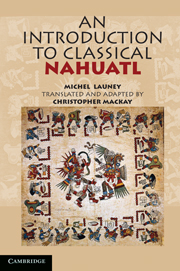Book contents
- Frontmatter
- Contents
- Preface
- How to Use This Book
- PART ONE
- PART TWO
- Lesson Sixteen Agent Nouns, the -ni Form
- Lesson Seventeen Compound Nouns, Verbal Incorporation
- Lesson Eighteen Bitransitive Verbs, Ambitransitive Verbs
- Lesson Nineteen Causative Verbs
- Lesson Twenty Applicative Verbs
- Lesson Twenty-One Honorific and Deprecatory Verbs
- Lesson Twenty-Two Pluperfect, Counterfactual, Vetitive, Directional Conjugations
- Lesson Twenty-Three Morphological Peculiarities of Certain Nouns and Verbs
- Lesson Twenty-Four More on Locatives
- Lesson Twenty-Five More on Quantifiers
- Lesson Twenty-Six Details about Number and Person, Indefinite Pronouns and Adverbs
- Lesson Twenty-Seven Compound Verbs
- Lesson Twenty-Eight Reduplication outside of the Plural, More on Verbs
- Lesson Twenty-Nine Derivative Verbs
- Lesson Thirty Derivative Nouns
- Lesson Thirty-One Noun Clauses
- Lesson Thirty-Two Attributives, Relative Clauses, Copula Verbs, Semi-Auxiliaries
- Lesson Thirty-Three Comparisons, Clauses of Result, Purpose and Cause
- Lesson Thirty-Four Conditions, More Particles
- Lesson Thirty-Five Temporal Clauses, Particles, Interjections
- Appendix One Traditional Orthography
- Appendix Two The Aztec Calendar
- Appendix Three Inflexional Patterns
- Appendix Four Key to the Exercises
- Nahuatl-to-English Vocabulary
- English-to-Nahuatl Vocabulary
- Index
Lesson Thirty-Three - Comparisons, Clauses of Result, Purpose and Cause
Published online by Cambridge University Press: 05 June 2012
- Frontmatter
- Contents
- Preface
- How to Use This Book
- PART ONE
- PART TWO
- Lesson Sixteen Agent Nouns, the -ni Form
- Lesson Seventeen Compound Nouns, Verbal Incorporation
- Lesson Eighteen Bitransitive Verbs, Ambitransitive Verbs
- Lesson Nineteen Causative Verbs
- Lesson Twenty Applicative Verbs
- Lesson Twenty-One Honorific and Deprecatory Verbs
- Lesson Twenty-Two Pluperfect, Counterfactual, Vetitive, Directional Conjugations
- Lesson Twenty-Three Morphological Peculiarities of Certain Nouns and Verbs
- Lesson Twenty-Four More on Locatives
- Lesson Twenty-Five More on Quantifiers
- Lesson Twenty-Six Details about Number and Person, Indefinite Pronouns and Adverbs
- Lesson Twenty-Seven Compound Verbs
- Lesson Twenty-Eight Reduplication outside of the Plural, More on Verbs
- Lesson Twenty-Nine Derivative Verbs
- Lesson Thirty Derivative Nouns
- Lesson Thirty-One Noun Clauses
- Lesson Thirty-Two Attributives, Relative Clauses, Copula Verbs, Semi-Auxiliaries
- Lesson Thirty-Three Comparisons, Clauses of Result, Purpose and Cause
- Lesson Thirty-Four Conditions, More Particles
- Lesson Thirty-Five Temporal Clauses, Particles, Interjections
- Appendix One Traditional Orthography
- Appendix Two The Aztec Calendar
- Appendix Three Inflexional Patterns
- Appendix Four Key to the Exercises
- Nahuatl-to-English Vocabulary
- English-to-Nahuatl Vocabulary
- Index
Summary
Comparative
Many languages (particularly Indo-European ones) have special markers to indicate the comparative (forms meaning, e.g., ‘bigger’, ‘more exciting’). In English, the comparative is usually formed by either placing ‘more’ in front of the adjective (‘more interesting’) or adding ‘-er’ to the word in the case of monosyllabic adjectives (‘hotter’). This comparatively straightforward procedure does not apply to Nahuatl, which has several phrases available to say ‘X is more adjective than Y’. In English, the phrase indicating the person/thing against which the comparison is made is introduced with ‘than’ and follows the comparative. For the sake of convenience, we will use the express “than-phrase” to refer to the corresponding part of the Nahuatl comparison (even though there is no simple word for ‘than’).
A major type of comparative phrase consists of saying (with assorted variants), ‘X is adjective, Y not’. There is often a mark of intensification in front of the “adjective”. This can be oc ‘still’, cencâ ‘very’, achi ‘rather’, yê ‘yet’ (see 33.7), or more often with a combination of these: oc achi (most frequent), oc cencâ, oc yê, oc yê achi, oc yê cencâ:
Tāchcāuh ‘strongly’ or huālcâ ‘more’ can be used in place of achi or cencâ, but most commonly oc tāchcāuh or oc huālcâ is followed by inic:
Tlapanahuia ‘it is surpassing’ can also be used:
Note carefully that in these constructions we do not have **oc nitāchcāuh/nihuālcâ or nitlapanahuia; these verbs remain in the third person singular because their subject is the clause inic nichicāhuac ‘how I'm strong’.
- Type
- Chapter
- Information
- An Introduction to Classical Nahuatl , pp. 340 - 351Publisher: Cambridge University PressPrint publication year: 2011

